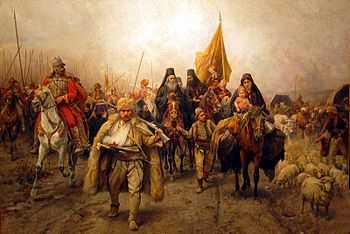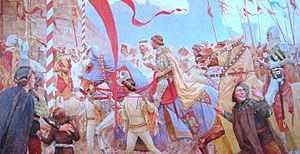Paja Jovanović
| Paja Jovanović Паја Јовановић | |
|---|---|
 Pavle "Paja" Jovanović | |
| Born |
June 16, 1859 Vršac, Voivodeship of Serbia and Banat of Temeschwar, Austrian Empire (today Serbia) |
| Died |
November 30, 1957 (aged 98) Vienna, Austria |
| Nationality | Serbian |
| Education | Academy of Fine Arts, Vienna |
| Known for | Painting |
| Notable work |
Čas Mačevanja (Fencing) (1884) Velike seobe Srba (Serbian Migrations) (1896) Krunisanje cara Dušana (Crowning of Stefan Dušan) (1900) |
| Movement | Realism |
| Website | |
| www.pajajovanovic.rs | |
Pavle "Paja" Jovanović (Serbian Cyrillic: Павле "Паја" Јовановић; IPA: [pâʋlɛ pǎːja jɔʋǎːnɔʋit͡ɕ]; 16 June 1859 – 30 November 1957) was a Serbian Realist painter. He is considered one of Serbia's greatest academic painters. His most famous and recognizable paintings are the Serbian Migrations, the Crowning of Stefan Dušan, the Takovo Uprising, Cockfighting, Decorating of the Bride, and the Fencing Lesson. He also painted many famous portraits. While many of his works can be seen in many European museums across the continent some have been lost, like Furor Teutonicus, a monumental oil on canvas depicting Battle of the Teutoburg Forest.
Biography
Paja Jovanović was born in Vršac, Voivodeship of Serbia and Banat of Temeschwar, Austrian Empire (today Vojvodina province, Serbia). His father was photographer Stevan Jovanović and his mother was Ernestina Jovanović, née Deot. He spent his childhood and early youth in this town, where he had the opportunity to see the iconostasis of Pavel Đurković and Arsa Teodorović in the town churches. He received his first lectures and knowledge from his teacher of painting, Vodecki. His father took him to Vienna in 1875 when he was 15, where he enrolled in the Academy of Fine Arts in 1877 in the class of the professor Christian Griepenkerl. He finished the Academy of Fine Arts in 1880, attending several important courses taught by Leopold Carl Müller, known as an “orientalist”. In the following period, having noticed greater interest of Europe for the Balkans, he painted mostly scenes from the life of the Albanians, Montenegrins, Herzegovinians, which brought him great reputation. Encouraged to visit the Balkan region during his hiatus, he studied the customs and folklore of the people, and in 1882 he was awarded the prize of the Academy and was given the czar scholarship for the composition The Wounded Montenegrin.

The public and many art critics directed their attention to the young painter, and in 1883 he signed a contract with the London gallery simply named “French”. He continued his travelling through Caucasus, Morocco, Egypt, Greece, Turkey, Italy, and Spain. A great number of sketches, notes, and studies, along with the collected objects from the life of the common people, will find their place in his famous genre-compositions, such as: Fencing, Decorating of the Bride, and Cockfighting. Some of Jovanović's most remarkable praises were gathered at two of his greatest exhibitions: Millennium exhibition in Budapest in 1896, where he prepared Migration of Serbs for entry, but Triptych was sent instead, and the World Exhibition in Paris in 1900, for which he had painted a great historical composition The Proclamation of Dušan's Law.
As early as in 1893 he was proclaimed for the member of the Serbian Royal Academy. He was given the task to make the monumental, historical compositions. After 1905 he devoted himself exclusively to painting the portraits in the style of academic realism for the rich clientele, and he became very famous thanks to them. Some of the most famous include Portrait of the Painter Simington, Portrait of Mihajlo Pupin, Portrait of the Artist's Wife Muni, Portrait of the Sculptor Đoka Jovanović, and others. He painted the portraits of his longtime model and wife, Muni with special care.
He made the iconostasis in the church in Dolovo and Saborna church in Novi Sad, which was painted without commission. He spent most of his time in his atelier in Vienna where he settled, and occasionally travelled to Belgrade. In 1940 he was given the title of the honorary citizen of Vršac, and in 1949 he was given the Order zasluga za narod (Merit for People) of the first category. He lived quietly and lonely, after his wife's early death, in Vienna until his own death in 1957. According to his will, the urn with his ashes was to be moved to Belgrade and where “The Legacy of Paja Jovanović” was opened in 1970, as well in Vršac. Later, in the building of the Old Pharmacy on the Stairs, in 1977 the permanent commemorative exhibition of Paja Jovanović was opened. The works of Paja Jovanović have been kept in the Town Museum of Vršac, along with the exceptionally famous Vršac Triptych. Most of his works and personal belongings can be found in the Town Museum of Belgrade.
Work
This is a partial list of works.
| Work | Year | Notes | Location | |
|---|---|---|---|---|
| Wounded Montenegrin | 1882 | oil on canvas, 186×114 cm | Gallery of Matica Srpska | Notes |
| Fancing | c. 1884 | oil on canvas, 60,5×40,5 cm | National Museum of Serbia | |
| Fancing | c. 1883 | sketch, pencil, 90,5 x 59 cm | Belgrade City Museum | |
| In Ambush | 1884–86 | oil on canvas, 27,5×38 cm | Gallery of Matica Srpska | |
| Arbanas | 1884–86 | oil on panel, 18×24,3 cm | Gallery of Matica Srpska | |
| Albanian with cibuk | 1884–86 | oil on panel, 36,5×43,5 cm | National Museum of Serbia | |
| Traitor | 1886 | oil on canvas, 148×100 cm | National Museum of Serbia | |
| Decorating Bride | 1886 | oil on canvas, 135×96,5 cm | National Museum of Serbia | |
| Forgiveness of Blood (Umir Krivi) | 1889 | oil on canvas,137×95 cm | Gallery of Matica Srpska | |
| Furor Teutonikus | 1889 | heliogravura, 81,7x62 cm | Belgrade City Museum | |
| Serbian Migrations | 1896 | oil on canvas, 190×126 cm | National Museum in Pančevo | |
| Serbian Migrations | c. 1895 | heliogravura; sketch, pencil, 94,8x62,3 cm / 119x84 cm | Belgrade City Museum | |
| Takovo Uprising | 1898 | oil on canvas, 190×125,5 cm | National Museum of Serbia | Valued at €3,000,000 |
| Sopocani Monastery | c. 1898 | oil on panel, 71,2×51,8 cm | National Museum of Serbia | |
| Proglašenje Dušanovog Zakonika | c. 1900 | oil on canvas, 126×190 cm | Belgrade City Museum | |
| Emperor Dušan's Crowning | c. 1900 | oil on canvas, 238×157 cm | National Museum of Serbia | |
| King Stefan of Dečani | c. 1900. | oil on canvas, 20×41 cm | National Museum of Serbia | |
| Rade Builder selling Monastery Manasija model | c. 1905. | oil on canvas, 53,3×36,5 cm | National Museum of Serbia | |
| King Milutin | 1906–1912. | oil on canvas, 131,5×201 cm | The Orthodox cathedral of Saint Nikolaj | |
| Archbishop Danilo | 1906–1912. | oil on canvas, 121×200 cm | The Orthodox cathedral of Saint Nikolaj | |
| Crusifixing | 1919. | oil on canvas 174×275 cm | Gallery of Matica Srpska | |
| Portrait of painter Simington | c. 1895. | oil on canvas, 76,5×99 cm | National Museum of Serbia | |
| Portrait of sculptor Đuro Jovanović | 1906–08. | oil on panel, 19,6×25 cm | Gallery of Matica Srpska | |
| Portrait of Mihailo Pupin | 1903. | oil on canvas, 96×114 cm | National Museum of Serbia | |
| Portrait of Ms. Pupin | 1903. | oil on canvas 80,5×103 cm | National Museum of Serbia | |
| Lady in pink dress | 1904. | oil on canvas, 62,3×117 cm | National Museum of Serbia | |
| Portrait of Dr. Shenk | 1906. | oil on canvas, 55×73 cm | Gallery of Matica Srpska | |
| Miss Hadson Portrait | 1910. | oil on canvas,89×150 cm | National Museum of Serbia | |
| Dancer Bergel | c. 1913. | oil on canvas, 92,5×126,5 cm | National Museum of Serbia | |
| Gedeon Dunđerski | 1916. | oil on canvas, 115×221 cm | National Museum of Serbia | |
| Sofia Dunđerski | 1916. | oil on canvas, 115×210,5 cm | Gallery of Matica Srpska | |
| Teodora Dunđerski | 1916–1920. | oil on canvas, 170×144 cm | Gallery of Matica Srpska | |
| Portrait of Kruna Bogdanović | 1919. | oil on canvas, 115×210 cm | private collection | |
| Portrait of Nikola Pašić | 1922–1926. | oil on canvas, 60,4×73 cm | National Museum of Serbia | |
| Wife Muni Portrait | 1925. | oil on canvas, 73×99 cm | Gallery of Matica Srpska | |
| Act in a red mantle | 1918–1920. | oil on canvas, 115x211cm | Belgrade City Museum | |
| Self-Portrait | c. 1930. | oil on canvas, 29×46 cm | Gallery of Matica Srpska | |
| Marshal Tito | 1947. | oil on canvas, 100×150,5 cm | National Museum of Serbia | |
| Marshal Tito | 1952. | sketch, 30,5 x 24 cm- | Belgrade City Museum | |
| Villa's Land – Parsifal's Dream | 1906. | litograph | Belgrade City Museum | |
| Knight Miloš, King Marko and the Vila | c. 1906. | oil on canvas, 33,5×53 cm | National Museum of Serbia | |
| Diana | 1906–1908. | oil on canvas, 77×68 cm | National Museum of Serbia | |
| Nude | 1906–1908. | oil on canvas, 40,5×50,5 cm | National Museum of Serbia | |
| Flowers | 1942. | oil on panel, 30×40,2 cm | National Museum of Serbia | |
| Flowers | c. 1950. | oil on panel, 30,5×40,5 cm | Belgrade City Museum | |
| Portrait of Queen Maria Karađorđević | 1925–1930. | oil on canvas, 210×102 cm | Belgrade City Museum | |
| Portrait of Milutin Milanković | 1943. | oil on canvas | Gallery of Matica Srpska | |
| Portrait of Milutin Milanković | 1945. | pen and chalk scetch, 29,8 h 36,7 cm | Belgrade City Museum |
Gallery
-

The Wedding of Emperor Stefan Dušan
-

The Fencing lesson
-

The Wounded Montenegrin
-
_The_Sword_Dance%2C_Private_Collection.jpg)
The Sword Dance
-

Miloš, Marko and the Fairy
Further reading
- A Survey of Serbian art by Ljubica D. Popovich
External links
| Wikimedia Commons has media related to Paja Jovanović. |
|